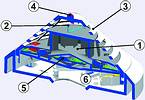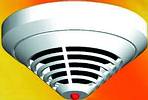
Bosch Security Systems South Africa boasts an impressive range of fire detectors for the local market, and continues to make inroads into the established and highly competitive fire detection sector, according to Shane Nefdt, Fire and Intrusion product manager at Bosch.
Says Nefdt, "The Bosch MAGIC.SENS fire detector range combines the standard detection principles of scattered light measurement in an optical chamber and temperature measurement. In addition, the C (chemical) variants include a unique chemical sensor, which detects the gases generated as a product of combustion."
"Modern signal analysis methods result in an error free alarm signal, which virtually eliminates the occurrence of false alarms," he says. "The addition of a chemical gas sensor in the MAGIC.SENS range, in conjunction with advanced signal processing, allows the detectors to be used in applications, where previously, point type smoke detectors were unsuitable," he adds.
The product range includes:
* Temperature detectors.
* Optical smoke detectors.
* Optical/temperature multisensors.
* Optical/chemical multisensors.
* Optical/temperature/chemical multisensors:
MAGIC.SENS sensors are available in the following communication protocols:
* LSN (local security network) - analog addressable technology.
* GLT (direct current circuit line technology) - conventional.

Operating principles of the detectors
Optical smoke sensor - the optical sensor works on the scattered light principle. An infra-red light emitting diode sends light into the optical chamber. In clean air the photo-diode receives no light from the IR LED because of the obtuse angle between the emitter and receiver and due to the absorbent properties of the labyrinth structure. Under fire conditions, smoke particles, entering the chamber, will cause the IR light to be scattered onto the photo- diode, resulting in an electrical signal proportional to the smoke density and its characteristics.
Temperature sensor - the temperature sensor uses a single thermistor located within a resistor network whose electrical output is directly proportional to the ambient air temperature. Both rate of rise and fixed temperature elements can be achieved using a single thermistor, due to the signal processing of the detector microprocessor.
CO gas sensor - the CO gas sensor (3) primarily detects carbon monoxide (CO) gas, which is a result of combustion. In addition to the detection of CO gas, hydrogen (H) and nitrogen monoxide (NO) gases are detected which further enhances the detector response. The measuring principle of the CO gas results in an electrical signal being generated which is proportional to the gas concentration. The gas sensor also provides additional information which is used to eliminate false alarms.

System description
In the multisensor detector MAGIC.SENS . . . 400/410 LSN, up to three detection elements can be integrated:
1. Optical (for smoke),
2. Thermal (for heat),
3. CO (for gas).
All sensor signals are continuously weighted and combined by the internal electronic evaluation system. If a signal combination matches the stored fire signal pattern (typically known as an alarm signature), within the detector, an alarm will automatically be triggered. When programming the detectors OC, OT, O and T, a sensor signal combination according to the installation location and environment is selected and stored by the installer. Utilising the combination of sensor elements within the multisensor detectors, allows the detectors to be installed in areas where smoke, steam or dust is present. It is possible to program individual sensors to be controlled manually or by time via the LSN network (typically known as day/night sensitivity - time-based sensitivity).
For more information contact Shane Nefdt, Bosch Security Systems, 011 651 9699, [email protected], www.boschsecuritysystems.com

© Technews Publishing (Pty) Ltd. | All Rights Reserved.